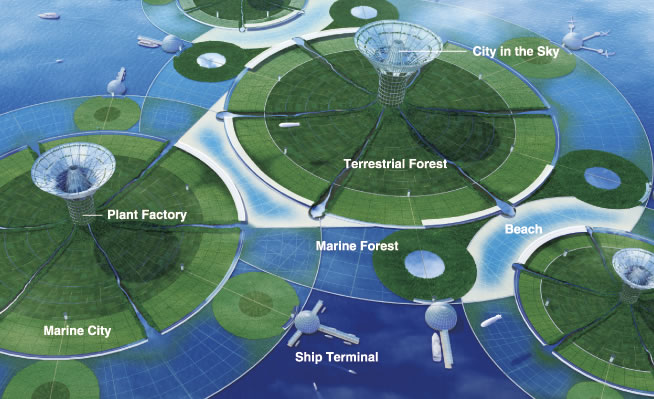Pitch
The Integrated Water-Energy-Nutrient Nexus (iWENN) Management Protocol Applies a System of Systems View to Marine Centric Resources.
Description
Summary
A System of Systems (SoS) view requires giving strong weight to the macro nature of broad spectrum problem solving. In simple terms, the SoS view aims for highly simpatico/synergistic results. The challenge of using SoS principles within the water, energy, nutrient nexus may best be met through linking as many potential shareholders as possible to the core issue of water, energy and nutrient security for the widest population as possible.
In Alexander Gillespie's remarkably comprehensive work Conservation, Biodiversity and International Law, (New Horizons in Environmental and Energy Law series) we find knowledge which is critical to planing any large scale solutions to the wide spectrum of goals within the water, energy, nutrient nexus as well as the related UN A2R initiative. Synthesizing the totality of the available knowledge on the vast number of related subjects and factors is challenging yet possible. Yet:
Where is the entry point for achieving a globally unifying on-the ground effort?
Well, it may not be actually found 'on-the-ground'!
This proposal offers a vision which is marine centric as the marine space offers the least complex technical-regulatory starting point as well as being potentially the most effective at the socio-environmental and profit levels and thus providing a highly synergistic solution nexus.
It is proposed that:
1) The deployment of large scale offshore cities to act as Oceanic Resources Conservation and Adaptation (ORCA) cities which can profitably mass produce vast amounts of sustainably produced C negative commodities for the global market.
2) Using portions of the profits generated by the ORCA operations to support UNHCR effort including using the ORCA cities as refugee/immigrant habitat.
3) Establish internationally recognized ORCA EEZs as legally protected regions for ocean conservation, production of vast amounts of freshwater, biofuel, biochar, food/feed, organic fertilizer, polymers, pharmaceuticals etc.
Category of the action
Mitigation/Adaptation, Changing public attitudes about climate change
What actions do you propose?

Fish Carbon: Exploring Marine Vertebrate Carbon Services:
"Fish Carbon provides a direct channel through which governments and the private sector can meet national, regional and global commitments on climate change and sustainability. The recognition and valuation of marine vertebrate carbon services may support policies to improve oceanic carbon function, thereby helping to mitigate climate change, and to improve marine ecosystem management."
"Although many advances have been made in the last few years, there are still many challenges associated with unlocking the values of coastal carbon and ecosystem services; and then turning them into revenue and management options. The science still contains many gaps, there are very few ‘proof of concept’ on-the-ground examples around the world, and the international community still does not fully recognize the value of these systems for climate change mitigation or adaptation.
The Blue Forests Project aims to address these challenges through coordinated on-the-ground demonstrations where better coastal ecosystem management is achieved by harnessing the values associated with carbon and ecosystem services, addressing key knowledge gaps, and providing experience and tools for greater global application. This four year project is an initiative of the United Nations Environment Programme (UNEP), funded by the Global Environment Facility (GEF) and co-financed by project partners, and managed by GRID-Arendal, a Norwegian foundation and center collaborating with UNEP."
Engineered approaches to blue carbon:
"A US Department of Energy study from 2001 proposed to replicate a natural process of carbon sequestration in the ocean by combining water rich in CO2 gas with carbonate[CO3-] to produce a bicarbonate [HCO3-] slurry. Practically, the engineered process could involve hydrating the CO2 from power plant flue gas and running it through a porous bed of limestone to ‘fix’ the carbon in a saturated bicarbonate solution. This solution could then be deposited at sea to sink in the deep ocean. The cost of this process, from capture to ocean burial, was estimated to range between $90 to "A US Department of Energy study from 2001 proposed to replicate a natural process of carbon sequestration in the ocean by combining water rich in CO2 gas with carbonate[CO3-] to produce a bicarbonate [HCO3-] slurry. Practically, the engineered process could involve hydrating the CO2 from power plant flue gas and running it through a porous bed of limestone to ‘fix’ the carbon in a saturated bicarbonate solution. This solution could then be deposited at sea to sink in the deep ocean. The cost of this process, from capture to ocean burial, was estimated to range between $90 to $180 per tonne of CO2 and was highly dependent on the distance required to transport limestone, seawater, and the resulting bicarbonate solution.80 per tonne of CO2 and was highly dependent on the distance required to transport limestone, seawater, and the resulting bicarbonate solution.
Expected benefits from bicarbonate production over direct CO2 gas injection would be a significantly lesser increase in ocean acidity and a longer timescale for burial before the captured carbon would be released back to the atmosphere.[43]"
Finding the adequate financial support to set up a coastal carbon project or program is not an undemanding task. However, reports like this one, or other tools and resources, are trying to ease the way through the climate finance jungle. Wetland –coastal or other – conservation and restoration efforts are more important than ever, and climate finance can help materialize some real implementation on the ground. Climate change finance, additionally coupled and leveraged through biodiversity finance, offers a suite of funding, as well as a plethora of financial mechanisms to support the conservation and restoration of wetlands worldwide, yet is not easy to get hold off. This report tried to provide the reader interested in coastal carbon activities with a first overview of the types of finance available. The scope and scale as well as the geographical and political situation will determine which mechanism, or which A final word 8 A final word combination of mechanisms, is accessible for the development and implementation of a particular wetland carbon project or program. The stated literature and reading sources provide further insights and details for the reader to engage much deeper with a specific fund and/or financial mechanism. And as a final note, it has to be borne in mind that financing for climate change, biodiversity, and water resources will remain a quickly changing subject matter for quite some years to come; and, therefore, checking the information against the latest on the provided websites is a wise approach.
The below is accredited to: http://www.ne.jp/asahi/mh/u/HoriCNES_ES.pdf
Per: The National Climate Assessment, Chapter 28: Adaptation. US Global Change Research Program:
Who will take these actions?
Where will these actions be taken?
What are other key benefits?
11 - 20 JULY 2016, NEW YORK | MINISTERIAL DAYS FROM 18 - 20 JULY
The High-level Political Forum on Sustainable Development is United Nations central platform for the follow-up and review of the 2030 Agenda for Sustainable Development and the Sustainable Development Goals, adopted at the United Nations Sustainable Development Summit on 25 September 2015.
The Forum, which adopts a Ministerial Declaration, is expected to start effectively delivering on its mandates to provide political leadership, guidance and recommendations on the 2030 Agenda's implementation and follow-up; keep track of progress; spur coherent policies informed by evidence, science and country experiences; as well as address new and emerging issues.
What are the proposal’s costs?
Profit generation needs to be viewed as being equally important as carbon capture, utilization, and sequestration STEM as well as the water, energy, nutrient nexus STEM. This type of project requires a vast level of investment and shareholder participation.
Below is a short list of related mitigation and adaptation initial funding efforts.
Under the Clean Development Mechanism (CDM), emission-reduction projects in developing countries can earn certified emission reduction (CER) credits. These credits can be traded and sold by industrialized countries to meet a part of their emission reduction targets under the Kyoto Protocol. Financing for the Adaptation Fund comes mainly from sales of certified emission reductions. The share of proceeds amounts to 2 percent of the value of CERs issued each year for CDM projects.
FAO begins deploying “fish magnets” to help Somali coastal communities
Foogle or GAO? Google Earth Director about the partnership with FAO
El Niño impact in Ethiopia and FAO destocking activity
FAO and China launch new South-South Cooperation Program in Democratic Republic of Congo
4th FAO Private Sector Partnerships Dialogue – Highlights from the Event
Time line
Related proposals
UN Oceanic Resources Conservation and Adaptation Platforms (O.R.C.A. Cities)
Algae Derived Ethylene Produces HDPE Algal Bioreactors: Repeat If Necessary!
Ocean Farming Hydrogen and Hydrogen Fueled Aircraft
References
Conservation, Biodiversity and International Law
Climate Finance: An interview with Sylvia Kreibiehl, Frankfurt School of Finance and Management
Alan Miller interview at the Asia LEDS Partnership Workshop on Climate Finance 'Scaling up worry'
GGGS 2013 Plenary I - Delivering Green Growth
GGGS 2013 Plenary II - Green Financing : Instruments, Institutions and Regulations
GGGS 2013 Plenary IV - Technology and Innovation
